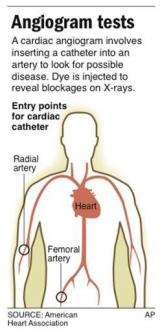Study suggests too many invasive heart tests given

(AP) -- A troublingly high number of U.S. patients who are given angiograms to check for heart disease turn out not to have a significant problem, according to the latest study to suggest Americans get an excess of medical tests.
The researchers said the findings suggest doctors must do better in determining which patients should be subjected to the cost and risks of an angiogram. The test carries a small but real risk - less than 1 percent - of causing a stroke or heart attack, and also entails radiation exposure.
"We can do better. There is no doubt in my mind," said Dr. Ralph Brindis of the University of California, San Francisco, one of the study's authors.
Every year in the United States, more than a million people get an angiogram, in which a thin tube is inserted in the arm or groin and threaded up to the heart to check for blocked arteries that could lead to a heart attack. Dye is injected through the tube to make blockages show up on X-rays.
Angiograms are often given to patients who might be having a heart attack or have symptoms that suggest a serious blockage. They are also sometimes done on people who may have some less clear-cut symptoms, like shortness of breath, or no symptoms but some risky traits like high cholesterol and an abnormal result on another heart test. This group accounts for about 20 to 30 percent of angiogram cases.
In the study, nearly two-thirds of the patients in this second group were found to have no serious blockages.
The researchers could not establish why so few proved to have heart disease. But Dr. Harlan Krumholz, a Yale cardiologist and health-outcomes researcher unconnected to the study, said he thinks the problem arises because doctors are afraid of missing something, and also getting sued.
"We fear doing too little," he said. "I think that we developed a culture where people feel that doing more and knowing more is always the proper course. What that does is sometimes lead us to overuse."
Researchers said more study is needed to sort out how to better select patients for an angiogram. For now, experts suggest patients in the category studied by the researchers question their doctors about the need for the test and the risks and alternatives.
To decide whether someone needs an angiogram, a doctor assesses a patient's medical status and symptoms, and usually tries a noninvasive test, such as an ultrasound of the heart or having the patient run on a treadmill. It is this gatekeeper process that needs improvement, researchers suggested in Thursday's issue of the New England Journal of Medicine.
They sifted through records of nearly 2 million angiograms performed at 663 U.S. hospitals between 2004 and April 2008. The data came from a registry kept by the American College of Cardiology, which sponsored the study.
The researchers focused on about 400,000 patients who raised doctors' suspicions but had no known heart disease and weren't getting emergency heart treatment.
In those people, the test revealed no significant artery blockages 62 percent of the time. That doesn't mean all those tests were unnecessary, but the rate is high enough to suggest doctors could do a better job of choosing who really needs the exam, researchers said.
The researchers suggested doctors should be less willing to order an angiogram for symptom-free patients, a group that made up 30 percent of the study sample.
Beyond that, further study might help doctors better gauge heart disease risk from a patient's symptoms and characteristics like age and history of other diseases, said lead author Dr. Manesh Patel of Duke University.
Doctors could also use more research to help them choose the right noninvasive test, which might reduce the need for angiograms, he said.
Choices now include the treadmill test, injecting a radioactive solution to trace blood flow within the heart, doing an ultrasound to watch the walls of the heart moving, and doing a specialized CT scan that has recently shown promise.
"We still haven't figured out, in all honesty, the best way of applying these technologies," Brindis said.
In fact, one of the study's co-authors - Dr. Pamela Douglas of Duke - just received a $32.5 million federal grant, the largest ever for heart imaging, to compare various heart imaging tests and see which ones do the most to prevent heart attacks, deaths and hospitalization.
Experts praised Patel's study.
Some previous reports have found similar results, but the new study is so huge "we can now feel comfortable these aren't isolated findings, this is for real," said Dr. Michael Lauer, director of the division of cardiovascular sciences at the National Heart, Lung and Blood Institute.
More information: New England Journal: http://www.nejm.org
©2010 The Associated Press. All rights reserved. This material may not be published, broadcast, rewritten or redistributed.














